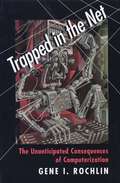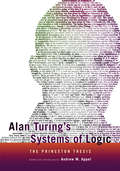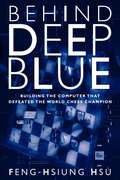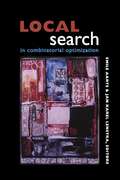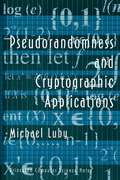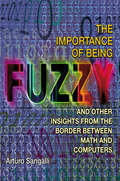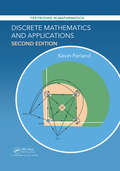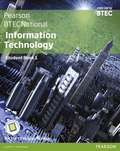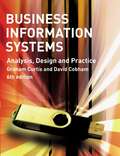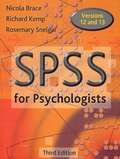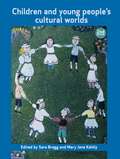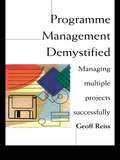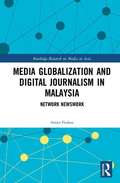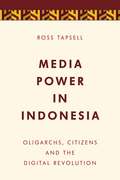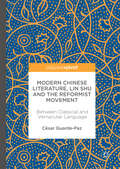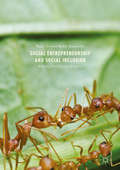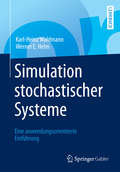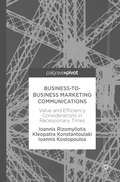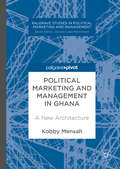- Table View
- List View
Trapped in the Net: The Unanticipated Consequences of Computerization
by Gene I. RochlinVoice mail. E-mail. Bar codes. Desktops. Laptops. Networks. The Web. In this exciting book, Gene Rochlin takes a closer look at how these familiar and pervasive productions of computerization have become embedded in all our lives, forcing us to narrow the scope of our choices, our modes of control, and our experiences with the real world. Drawing on fascinating narratives from fields that range from military command, air traffic control, and international fund transfers to library cataloging and supermarket checkouts, Rochlin shows that we are rapidly making irreversible and at times harmful changes in our business, social, and personal lives to comply with the formalities and restrictions of information systems. The threat is not the direct one once framed by the idea of insane robots or runaway mainframes usurping human functions for their own purposes, but the gradual loss of control over hardware, software, and function through networks of interconnection and dependence. What Rochlin calls the computer trap has four parts: the lure, the snare, the costs, and the long-term consequences. The lure is obvious: the promise of ever more powerful and adaptable tools with simpler and more human-centered interfaces. The snare is what usually ensues. Once heavily invested in the use of computers to perform central tasks, organizations and individuals alike are committed to new capacities and potentials, whether they eventually find them rewarding or not. The varied costs include a dependency on the manufacturers of hardware and software--and a seemingly pathological scramble to keep up with an incredible rate of sometimes unnecessary technological change. Finally, a lack of redundancy and an incredible speed of response make human intervention or control difficult at best when (and not if) something goes wrong. As Rochlin points out, this is particularly true for those systems whose interconnections and mechanisms are so deeply concealed in the computers that no human being fully understands them.
Trapped in the Net: The Unanticipated Consequences of Computerization
by Gene I. RochlinVoice mail. E-mail. Bar codes. Desktops. Laptops. Networks. The Web. In this exciting book, Gene Rochlin takes a closer look at how these familiar and pervasive productions of computerization have become embedded in all our lives, forcing us to narrow the scope of our choices, our modes of control, and our experiences with the real world. Drawing on fascinating narratives from fields that range from military command, air traffic control, and international fund transfers to library cataloging and supermarket checkouts, Rochlin shows that we are rapidly making irreversible and at times harmful changes in our business, social, and personal lives to comply with the formalities and restrictions of information systems. The threat is not the direct one once framed by the idea of insane robots or runaway mainframes usurping human functions for their own purposes, but the gradual loss of control over hardware, software, and function through networks of interconnection and dependence. What Rochlin calls the computer trap has four parts: the lure, the snare, the costs, and the long-term consequences. The lure is obvious: the promise of ever more powerful and adaptable tools with simpler and more human-centered interfaces. The snare is what usually ensues. Once heavily invested in the use of computers to perform central tasks, organizations and individuals alike are committed to new capacities and potentials, whether they eventually find them rewarding or not. The varied costs include a dependency on the manufacturers of hardware and software--and a seemingly pathological scramble to keep up with an incredible rate of sometimes unnecessary technological change. Finally, a lack of redundancy and an incredible speed of response make human intervention or control difficult at best when (and not if) something goes wrong. As Rochlin points out, this is particularly true for those systems whose interconnections and mechanisms are so deeply concealed in the computers that no human being fully understands them.
Alan Turing's Systems of Logic: The Princeton Thesis (PDF)
by Andrew W. AppelBetween inventing the concept of a universal computer in 1936 and breaking the German Enigma code during World War II, Alan Turing (1912-1954), the British founder of computer science and artificial intelligence, came to Princeton University to study mathematical logic. Some of the greatest logicians in the world--including Alonzo Church, Kurt Gödel, John von Neumann, and Stephen Kleene--were at Princeton in the 1930s, and they were working on ideas that would lay the groundwork for what would become known as computer science. This book presents a facsimile of the original typescript of Turing's fascinating and influential 1938 Princeton PhD thesis, one of the key documents in the history of mathematics and computer science. The book also features essays by Andrew Appel and Solomon Feferman that explain the still-unfolding significance of the ideas Turing developed at Princeton. A work of philosophy as well as mathematics, Turing's thesis envisions a practical goal--a logical system to formalize mathematical proofs so they can be checked mechanically. If every step of a theorem could be verified mechanically, the burden on intuition would be limited to the axioms. Turing's point, as Appel writes, is that "mathematical reasoning can be done, and should be done, in mechanizable formal logic." Turing's vision of "constructive systems of logic for practical use" has become reality: in the twenty-first century, automated "formal methods" are now routine. Presented here in its original form, this fascinating thesis is one of the key documents in the history of mathematics and computer science.
Behind Deep Blue: Building the Computer that Defeated the World Chess Champion (PDF)
by Feng-Hsiung HsuOn May 11, 1997, as millions worldwide watched a stunning victory unfold on television, a machine shocked the chess world by defeating the defending world champion, Garry Kasparov. Written by the man who started the adventure, Behind Deep Blue reveals the inside story of what happened behind the scenes at the two historic Deep Blue vs. Kasparov matches. This is also the story behind the quest to create the mother of all chess machines. The book unveils how a modest student project eventually produced a multimillion dollar supercomputer, from the development of the scientific ideas through technical setbacks, rivalry in the race to develop the ultimate chess machine, and wild controversies to the final triumph over the world's greatest human player. In nontechnical, conversational prose, Feng-hsiung Hsu, the system architect of Deep Blue, tells us how he and a small team of fellow researchers forged ahead at IBM with a project they'd begun as students at Carnegie Mellon in the mid-1980s: the search for one of the oldest holy grails in artificial intelligence--a machine that could beat any human chess player in a bona fide match. Back in 1949 science had conceived the foundations of modern chess computers but not until almost fifty years later--until Deep Blue--would the quest be realized. Hsu refutes Kasparov's controversial claim that only human intervention could have allowed Deep Blue to make its decisive, "uncomputerlike" moves. In riveting detail he describes the heightening tension in this war of brains and nerves, the "smoldering fire" in Kasparov's eyes. Behind Deep Blue is not just another tale of man versus machine. This fascinating book tells us how man as genius was given an ultimate, unforgettable run for his mind, no, not by the genius of a computer, but of man as toolmaker.
Local Search in Combinatorial Optimization
by Emile Aarts Jan Karel LenstraIn the past three decades, local search has grown from a simple heuristic idea into a mature field of research in combinatorial optimization that is attracting ever-increasing attention. Local search is still the method of choice for NP-hard problems as it provides a robust approach for obtaining high-quality solutions to problems of a realistic size in reasonable time. Local Search in Combinatorial Optimization covers local search and its variants from both a theoretical and practical point of view, each topic discussed by a leading authority. This book is an important reference and invaluable source of inspiration for students and researchers in discrete mathematics, computer science, operations research, industrial engineering, and management science. In addition to the editors, the contributors are Mihalis Yannakakis, Craig A. Tovey, Jan H. M. Korst, Peter J. M. van Laarhoven, Alain Hertz, Eric Taillard, Dominique de Werra, Heinz Mühlenbein, Carsten Peterson, Bo Söderberg, David S. Johnson, Lyle A. McGeoch, Michel Gendreau, Gilbert Laporte, Jean-Yves Potvin, Gerard A. P. Kindervater, Martin W. P. Savelsbergh, Edward J. Anderson, Celia A. Glass, Chris N. Potts, C. L. Liu, Peichen Pan, Iiro Honkala, and Patric R. J. Östergård.
Pseudorandomness and Cryptographic Applications
by Michael LubyA pseudorandom generator is an easy-to-compute function that stretches a short random string into a much longer string that "looks" just like a random string to any efficient adversary. One immediate application of a pseudorandom generator is the construction of a private key cryptosystem that is secure against chosen plaintext attack. There do not seem to be natural examples of functions that are pseudorandom generators. On the other hand, there do seem to be a variety of natural examples of another basic primitive: the one-way function. A function is one-way if it is easy to compute but hard for any efficient adversary to invert on average. The first half of the book shows how to construct a pseudorandom generator from any one-way function. Building on this, the second half of the book shows how to construct other useful cryptographic primitives, such as private key cryptosystems, pseudorandom function generators, pseudorandom permutation generators, digital signature schemes, bit commitment protocols, and zero-knowledge interactive proof systems. The book stresses rigorous definitions and proofs.
The Importance of Being Fuzzy: And Other Insights from the Border between Math and Computers
by Arturo SangalliHow has computer science changed mathematical thinking? In this first ever comprehensive survey of the subject for popular science readers, Arturo Sangalli explains how computers have brought a new practicality to mathematics and mathematical applications. By using fuzzy logic and related concepts, programmers have been able to sidestep the traditional and often cumbersome search for perfect mathematical solutions to embrace instead solutions that are "good enough." If mathematicians want their work to be relevant to the problems of the modern world, Sangalli shows, they must increasingly recognize "the importance of being fuzzy." As Sangalli explains, fuzzy logic is a technique that allows computers to work with imprecise terms--to answer questions with "maybe" rather than just "yes" and "no." The practical implications of this flexible type of mathematical thinking are remarkable. Japanese programmers have used fuzzy logic to develop the city of Sendai's unusually energy-efficient and smooth-running subway system--one that does not even require drivers. Similar techniques have been used in fields as diverse as medical diagnosis, image understanding by robots, the engineering of automatic transmissions, and the forecasting of currency exchange rates. Sangalli also explores in his characteristically clear and engaging manner the limits of classical computing, reviewing many of the central ideas of Turing and Godel. He shows us how "genetic algorithms" can solve problems by an evolutionary process in which chance plays a fundamental role. He introduces us to "neural networks," which recognize ill-defined patterns without an explicit set of rules--much as a dog can be trained to scent drugs without ever having an exact definition of "drug." Sangalli argues that even though "fuzziness" and related concepts are often compared to human thinking, they can be understood only through mathematics--but the math he uses in the book is straightforward and easy to grasp. Of equal appeal to specialists and the general reader, The Importance of Being Fuzzy reveals how computer science is changing both the nature of mathematical practice and the shape of the world around us.
Discrete Mathematics and Applications, Second Edition (Textbooks in Mathematics)
by Kevin FerlandThis book is intended for a one-semester course in discrete mathematics. Such a course is typically taken by mathematics, mathematics education, and computer science majors, usually in their sophomore year. Calculus is not a prerequisite to use this book. Part one focuses on how to write proofs, then moves on to topics in number theory, employing set theory in the process. Part two focuses on computations, combinatorics, graph theory, trees, and algorithms.
Information Technology (PDF)
by Jenny Phillips Alan Jarvis Mark Fishpool Richard Mcgill Tim Cook David Atkinson-BeaumontEach Student Book and ActiveBook have has clearly laid out pages with a range of supportive features to aid learning and teaching: Getting to know your unit sections ensure learners understand the grading criteria and unit requirements. Getting ready for Assessment sections focus on preparation for external assessment with guidance for learners on what to expect. Hints and tips will help them prepare for assessment and sample answers are provided for a range of question types including, short and long answer questions, all with a supporting commentary. Learners can also prepare for internal assessment using this feature. A case study of a learner completing the internal assessment for that unit covering 'How I got started', 'How I brought it all together' and 'What I got from the experience'. Pause Point feature provide opportunities for learners to self-evaluate their learning at regular intervals. Each Pause Point point feature gives learners a Hint or Extend option to either revisit and reinforce the topic or to encourage independent research or study skills. Case Study and Theory into Practice features enable development of problem-solving skills and place the theory into real life situations learners could encounter. Assessment Activity/Practice provide scaffolded assessment practice activities that help prepare learners for assessment. Within each assessment practice activity, a Plan, Do and Review section supports learners' formative assessment by making sure they fully understand what they are being asked to do, what their goals are and how to evaluate the task and consider how they could improve. Dedicated Think Future pages provide case studies from the industry, with a focus on aspects of skills development that can be put into practice in a real work environment and further study.
Business Information Systems: Analysis, Design And Practice (PDF)
by Graham Curtis David CobhamThis book aims to equip those in, or entering business to assess the opportunities, limitations and major issues surrounding modern business information systems and to appreciate the way that information systems can aid the realization of business objectives. This book provides students with: good technical coverage, accessible coverage for both business students and computing students, interesting case studies, including a running case throughout the systems development chapters, showing real world application of ideas and technologies, European context and examples PowerPoint slides and additional test questions for Lecturers online. New to this edition? Chapters 10-15 on Systems Development, Analysis and Design have been replaced by new chapters taking an object oriented approach. The structured approach is still summarised in chapter 16 and the content from the previous edition is included in full online in the Companion Website. Case studies, questions and activities have been updated throughout. An introduction or increased focus on current topics such as globalisation, agile methods, E-Business, security and trust, off the shelf solutions, CRM, legacy systems integration, business intelligence, data warehousing and data mining.
SPSS for Psychologists, Third Edition (PDF)
by Nicola Brace Richard Kemp Rosemary SnelgarThe new edition of this best-selling guide carefully leads the user through the process of using SPSS to analyze psychological data. The authors review the basic issues regarding design and proceed through all of the major statistical techniques used in
Children and Young People's Cultural Worlds (PDF)
by Lesley Gallacher Sara Bragg Mary Jane KehilyGrowing up in an increasingly media-saturated, commercial, and globalized world, children and young people in contemporary society encounter and must creatively adapt to a range of cultural phenomena. Offering a critical introduction to childhood in the digital age, Children and Young People's Cultural Worlds challenges common concepts and concerns about childhood innocence held by many adults. It examines the diversity of childhood experiences and relationships--the distinctiveness of children's worlds--and explores topics such as the consequences of age and the experience of living in different cultural contexts. Utilizing contributions from scholars in a variety of different fields, it is interdisciplinary and international in scope. Including resources for teachers and students such as learning outcomes, activities, and additional readings and commentary, this well-written and beautifully presented book will be a valuable resource to anyone interested in new perspectives on childhood in the digital age.
Programme Management Demystified: Managing Multiple Projects Successfully
by Geoff ReissThis book provides the perfect companion to Geoff Reiss's Project Management Demystified and presents the techniques of multi-project management in a lively, approachable manner. It covers budgets, cost control, planning problems and matrix management formulae. Drawing on a wide range of case histories and lively examples, it tackles organisational issues and the multi-project conflicts that often arise.
Media Globalization And Digital Journalism In Malaysia: A Hierarchy Of Influences On Network Newswork In Glocal Spheres (PDF)
by Amira Sariyati Binti FirdausThe media ecology within which conventional mainstream journalism currently operates has undergone major transformations since the advent of social media. These transformations arise from the disruption brought upon by the emergence of networked, interactive platforms and user-driven online applications including social media, blogs and alternative citizen news sites. This book analyses networked forms of journalistic production at traditional news organizations and their conventional news channels. Focusing on case studies from Malaysia, it examines current transformations to the norms, practices and values of conventional news production. Drawing upon a recent global-comparative turn in journalism studies and parallel efforts to de-Westernize communication theory, this book suggests an innovative #65533;glocal#65533; comparative approach to analyse #65533;network newswork#65533; among global, transnational, and local news organizations, including Al Jazeera and Bernama TV, located within the same geographical locality, Kuala Lumpur, Malaysia. This author uses an empirically-grounded conceptual framework for exploring and understanding recent transformations that user-driven networked resources bring to professional journalists#65533; daily work of producing news. Discussing the implications of network newswork on the wider global journalistic sphere, the book elucidates a tiered model of networked sources and expounds upon journalism#65533;s deepening of the digital divide in its inadvertent muting of the voices of non-networked communities that are switched off from the global news sphere and its network society. A fresh perspective on the analysis of globalization in the media and a useful guide for gaining access into media organizations and securing cooperation of organizational members for research, this book will be of interest to researchers in the field of Asian Media and Communication Studies, Journalism Studies, Political Communication and Sociology of Journalism.
Media Power in Indonesia: Oligarchs, Citizens and the Digital Revolution (PDF)
by Ross TapsellIndonesia is undergoing a process of rapid change, with an affluent middle class due to hit 141 million people by 2020. While official statistics suggest that internet penetration is low, over 70 million Indonesians have a Facebook account, the fourth highest group in the world. Jakarta is the Twitter capital of the world with more tweets per minute than any other city around the globe. In the past ten years digitalisation of media content has enabled extensive concentration and conglomeration of the industry, and media owners are wealthier and more politically powerful than ever before. Digital media is a prominent place of contestation between large, powerful oligarchs, and citizens looking to bring about rapid and meaningful change. This book examines how the political agencies of both oligarchs and 'netizens' are enhanced by digitalisation, and how an increasingly divergent society is being formed. In doing so, this book enters this debate about the transformations of society and power in the digital age.
Producing Great Sound For Film And Video: Expert Tips From Preproduction To Final Mix (PDF)
by Jay RoseIn Producing Great Sound for Film and Video, Fourth Edition audio guru Jay Rose revises his popular text for a new generation of filmmakers. You'll learn practical, time-saving ways to get better recordings, solve problems with existing audio, create compelling tracks, and boost your filmmaking to the next level! Here you'll find real-world advice and practical guidelines for every aspect of your soundtrack: planning and budgeting, field and studio recording, editing, sound effects and music, audio repair, processing, and mixing. Rose's combination of solid technical information and a clear, step-by-step approach has made this the go-to book for producers and film students for over a decade. New in this edition: Insights and from-the-trenches tips from top professionals Instructions for getting the best results from new DSLRs and digital recorders An all-new companion website www. GreatSound. infowith downloadable diagnostics, examples, and exercises for you to try What you need to know about new regulations for wireless mics and broadcast loudness An expanded "How Do I Fix This?" section to help you solve problems quickly Whether you're an aspiring filmmaker who wants better tracks, or an experienced professional looking for a reference, Producing Great Sound for Film and Video, Fourth Editionhas the information you need. Please visit the book's companion website for more information and companion files: http://www. GreatSound. info
Modern Chinese Literature, Lin Shu and the Reformist Movement: Between Classical and Vernacular Language
by César Guarde-PazThis Pivot reconsiders the controversial literary figure of Lin Shu and the debate surrounding his place in the history of Modern Chinese Literature. Although recent Chinese mainland research has recognized some of the innovations introduced by Lin Shu, he has often been labeled a 'rightist reformer' in contrast to 'leftist reformers' such as Chen Duxiu and the new wave scholars of the May Fourth Movement. This book provides a well-documented account of his place in the different polemics between these two circles ('conservatives' and 'reformers') and provides a more nuanced account of the different literary movements of the time. Notably, it argues that these differences were neither in content nor in politics, but in the methodological approach of both parties. Examining Lin Shu and the 'conservatives' advocated coexistence of both traditional and modern thought, the book provides background to the major changes occurring in the intellectual landscape of Modern China.
Modern Chinese Literature, Lin Shu and the Reformist Movement: Between Classical and Vernacular Language
by César Guarde-PazThis Pivot reconsiders the controversial literary figure of Lin Shu and the debate surrounding his place in the history of Modern Chinese Literature. Although recent Chinese mainland research has recognized some of the innovations introduced by Lin Shu, he has often been labeled a 'rightist reformer' in contrast to 'leftist reformers' such as Chen Duxiu and the new wave scholars of the May Fourth Movement. This book provides a well-documented account of his place in the different polemics between these two circles ('conservatives' and 'reformers') and provides a more nuanced account of the different literary movements of the time. Notably, it argues that these differences were neither in content nor in politics, but in the methodological approach of both parties. Examining Lin Shu and the 'conservatives' advocated coexistence of both traditional and modern thought, the book provides background to the major changes occurring in the intellectual landscape of Modern China.
Social Entrepreneurship and Social Inclusion: Processes, Practices, and Prospects
by Rama Krishna KummithaThis book argues that embeddedness and community participation bring unique propositions for social entrepreneurship to foster social inclusion. It uncovers the role of local knowledge and grassroots level innovations to create necessary environment for the positive social change to roll. Social enterprises have proven to reduce drudgery of poor and excluded by offering creative and innovative solutions for long standing social problems. The grassroots level creative problem solving mechanisms they initiate travel through a variety of local dynamics and cultural contexts. However, social innovations quite often do not achieve their intended results, especially when they fail to understand the local contexts and embed themselves in such dynamism. In this background, the book attempts to understand and analyse the 'connect' between the social innovations and local dynamism. It argues that the community-driven innovation management which is based on local knowledge inspires the social entrepreneurial process and builds capacities and infrastructure to foster social inclusion. Each chapter in this book offers development scholars rich narration about how social problems have been approached, addressed, and altered through rich insights from communities and the social entrepreneurial teams.
Social Entrepreneurship and Social Inclusion: Processes, Practices, and Prospects
by Rama Krishna KummithaThis book argues that embeddedness and community participation bring unique propositions for social entrepreneurship to foster social inclusion. It uncovers the role of local knowledge and grassroots level innovations to create necessary environment for the positive social change to roll. Social enterprises have proven to reduce drudgery of poor and excluded by offering creative and innovative solutions for long standing social problems. The grassroots level creative problem solving mechanisms they initiate travel through a variety of local dynamics and cultural contexts. However, social innovations quite often do not achieve their intended results, especially when they fail to understand the local contexts and embed themselves in such dynamism. In this background, the book attempts to understand and analyse the 'connect' between the social innovations and local dynamism. It argues that the community-driven innovation management which is based on local knowledge inspires the social entrepreneurial process and builds capacities and infrastructure to foster social inclusion. Each chapter in this book offers development scholars rich narration about how social problems have been approached, addressed, and altered through rich insights from communities and the social entrepreneurial teams.
Simulation stochastischer Systeme: Eine anwendungsorientierte Einführung (PDF)
by Werner E. Helm Karl-Heinz WaldmannDas vorliegende Lehrbuch ist eine umfassende Einführung in die Simulation stochastischer Systeme. Auf 400 Seiten wird der Leser an stochastische Simulationsmodelle, Lösungsmethoden und statistische Analyseverfahren herangeführt. Die grundlegenden Sachverhalte werden ausführlich motiviert und begründet. Das Buch kann im Bachelor- und Masterbereich an Universitäten und Hochschulen eingesetzt werden. Untersuchungsgegenstand und Herangehensweise machen es interessant für Wirtschaftswissenschaftler, aber auch für Ingenieure, Mathematiker und Naturwissenschaftler. Vorausgesetzt werden die Grundbegriffe der Wahrscheinlichkeitsrechnung und elementaren Statistik; die tatsächlich benötigten Elemente werden im Anhang bereitgestellt. Das Buch ist stringent in der Darstellung. Es ermöglicht ‚Learning by Example‘ und ‚Learning by Doing‘ und kann zum Selbststudium verwendet werden. Jedes neue Konzept wird durch Beispiele, Abbildungen und Aufgaben begleitet, die ein schnelles Verstehen und Übertragen auf eigene Problemstellungen ermöglichen.
Business-to-Business Marketing Communications: Value and Efficiency Considerations in Recessionary Times
by Ioannis Rizomyliotis Kleopatra Konstantoulaki Ioannis KostopoulosThis book addresses the rapidly changing Business-to-Business (B2B) marketing communication landscape, in particular the shrinking of marketing budgets and the increasing demand for measurable results. Despite the rapid drop of print media usage, the authors suggest the need for increased accountability for the use of advertising media and highlight ways to boost effectiveness. The book provides a robust analysis of the current B2B environment along with a research-informed illustration of the future. Aiming to fill a gap in existing literature and offer new research findings, this study offers a comprehensive guide to assist practitioners in decision-making and a stimulating analysis of the B2B marketing communications landscape which will be of great interest to academics of marketing and communications.
Business-to-Business Marketing Communications: Value and Efficiency Considerations in Recessionary Times
by Ioannis Rizomyliotis Kleopatra Konstantoulaki Ioannis KostopoulosThis book addresses the rapidly changing Business-to-Business (B2B) marketing communication landscape, in particular the shrinking of marketing budgets and the increasing demand for measurable results. Despite the rapid drop of print media usage, the authors suggest the need for increased accountability for the use of advertising media and highlight ways to boost effectiveness. The book provides a robust analysis of the current B2B environment along with a research-informed illustration of the future. Aiming to fill a gap in existing literature and offer new research findings, this study offers a comprehensive guide to assist practitioners in decision-making and a stimulating analysis of the B2B marketing communications landscape which will be of great interest to academics of marketing and communications.
Political Marketing and Management in Ghana: A New Architecture (PDF)
by Kobby MensahThis book focuses on the emergence of new frames of political engagement underpinned by concepts in marketing, management, and organisation. It goes beyond political electioneering and campaigning and considers business theories such as market research, segmentation, social media, brand architecture, and human resources. With contributions from a range of skilled experts, Political Marketing and Management in Ghana emphasises and provides insights on the symbols-oriented approach of political campaigning in Africa, and distinguishes this from the technology-driven process of the west. Offering a total understanding of African politics and its supply and demand interactivity between key actors, this book is of great use to academics interested in political science, communications, marketing, and business and management.
Political Marketing and Management in Ghana: A New Architecture
by Kobby MensahThis book focuses on the emergence of new frames of political engagement underpinned by concepts in marketing, management, and organisation. It goes beyond political electioneering and campaigning and considers business theories such as market research, segmentation, social media, brand architecture, and human resources. With contributions from a range of skilled experts, Political Marketing and Management in Ghana emphasises and provides insights on the symbols-oriented approach of political campaigning in Africa, and distinguishes this from the technology-driven process of the west. Offering a total understanding of African politics and its supply and demand interactivity between key actors, this book is of great use to academics interested in political science, communications, marketing, and business and management.
